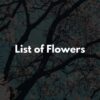「植物学」で使う英語一覧【葉緑素・高山植物など】【例文あり】

たとえば、以下は英語で何と表現すればよいのでしょうか?
- 芽
- 茂み
- 枯葉
- おしべ
- めしべ
- 植物学
- 葉緑素
- 高山植物
- 食虫植物
今回は植物学で使う英語表現について、簡単にお伝えします。
植物学の英語表現
| alga | 藻 |
| alpine plants | 高山植物 |
| angiosperm | 被子植物 |
| annual | 一年生の |
| asexual | 無性の |
| bark | 樹皮 |
| biennial | 二年生の |
| bisexual | 両性の |
| botany | 植物学 |
| broad leaves tree | 広葉樹 |
| bud | 芽 |
| bush | 茂み |
| carbon dioxide | 二酸化炭素 |
| chloryophyll | 葉緑素 |
|
conifer tree coniferous tree |
針葉樹 |
| deciduous tree | 落葉樹 |
| dry leaves | 枯葉 |
| embryo | 胚・胎芽 |
| evaporate | 蒸発する |
| evaporation | 蒸発 |
| evergreen | 常緑樹 |
| fallen leaves | 落ち葉 |
| fern | シダ, シダ類 |
| fertilization | 受精・受胎 |
| fiber | 繊維 |
| fiber cell | 線維細胞 |
| flora | 植物相 |
| floral leaves | 花葉 |
| floret | キク科の小さい花 |
| flowering plants | 花木・顕花植物 |
| fungus | 菌類・キノコ類 |
| genotype | 遺伝子型 |
| germinate | 発芽する、成長する |
| grass | 草 |
| gymnospermae | 裸子植物 |
| herb | ハーブ、草木植物 |
| hybrid | 雑種・交配種 |
| insectivorous plant | 食虫植物 |
| land plants | 陸上植物 |
| leaf | 葉っぱ |
| lichen | コケ・地衣類 |
| limb | 大枝 |
| mangrove | マングローブ |
| mold | カビ |
| moss | コケ・蘚類 |
| naturalize plants | 帰化植物 |
| non-flowering plants | 花が咲かない植物 |
| offspring | 子孫 |
| oxygen | 酸素 |
| parasite plants | 寄生植物 |
| perennial | 多年生の |
| petal | 花弁、花びら |
| phenotype | 表現型 |
| photosynthesis | 光合成 |
| pistil | めしべ |
| plant kingdom | 植物界 |
| pollen | 花粉 |
| reproduction | 生殖 |
| rhizome | 根茎 |
| root | 根 |
| sap | 樹液 |
| seed | 種子 |
| sepal | がく片 |
| sexual | 性の |
| shrub | 低木、灌木 |
| specimen | 標本 |
| spermatophyte | 種子植物 |
| spore | 胞子、種子 |
| sprout | 芽 |
| stalk | 植物の茎・幹 |
| stamen | おしべ |
| stem | 茎 (くき) |
| stoma | 気孔 |
| trunk | 幹 |
| twig | 小枝 |
| weed | 雑草、草むしりをする |
植物学関連の英語表現例
上記一覧のすべての単語を網羅しているわけではありません。ご参考までに。
It can lead to root rot.
根腐れの原因になります
Spores spread and formed mold.
胞子が拡散して、カビができた
I studied botany at the university.
大学では植物学を専攻していました
That may be insectivorous plants.
食虫植物かもしれません
The breeze whirled the dry leaves.
そよかぜが枯葉をゆらしていた
Each pink petal has a stripe of white.
ピンクの花びらそれぞれに、白のストライプが入っている
She added fertilizer to enrich the soil.
土壌を豊かにするために、彼女は肥料を加えた
Many conifer trees stand in the forest.
森には多くの針葉樹が林立しています
Somebody is lurking behind that bush.
あの茂みの裏、誰か潜んでいる
These flowers died from lack of moisture.
花が水分不足で枯れました
A limb of the tree snapped under his feet.
足元で木の枝が折れた
The insectivorous plant captures houseflies.
その食虫植物はハエを捕まえます
The seeds will sprout in a week after you sow.
種をまいたあと、一週間で芽が出ます
He cut the grass by using a lawnmower this morning.
今朝彼は、草刈り機を使って草を刈りました
The radiation exposure led to malformation of the embryo.
放射線被ばくで、胚が奇形を起こした
The gardener is piling up fallen leaves in the corner of the backyard.
庭師が裏庭の隅に落ち葉を積み上げています
I got rid of all the mold not too long ago, but I’ll deal with mold now.
こないだカビ取りしたばっかりだけど、今カビ取りします
I’m looking for a good place where seeds germinate and nourish plants.
種が発芽し植物が育ついい場所を探しています
I don’t know the difference between spermatophytes and gymnospermaes.
種子植物と裸子植物の違いがわかりません
In this botanical garden, about 1,200 species of alpine plants are on display.
この植物園では、約1200もの高山植物が展示されています
I weeded to prevent grass from establishing itself at the necks of shrubs planted.
植えられた低木の根元に草が生えないよう、草むしりをしました
まとめ
「植物学」で使う英語一覧、いかがでしたでしょうか。上記の表現例を応用して日々の英会話シーンで使っていただけたら、うれしいです。ご参考までに。
botany
植物学
botanical garden
植物園
root rot
根腐れ
fertilizer
肥料
soil
土壌
sow
種をまく
cut the grass
草刈りをする
lawnmower
草刈り機
lead to …
… につながる
spread
広がる
form
形作る
breeze
そよかぜ
whirl
ゆらす
enrich
豊かにする
lurk
ひそむ
moisture
水分
lack of …
… 不足
snap
折れる
housefly
ハエ
radiation exposure
放射線被ばく
malformation
奇形
gardener
庭師
be piled up …
… を積み上げる
yard
庭 (小さめ)
garden
庭 (大きめ)
look for …
… を探す
nourish
植物が育つ
difference
違い
on display
展示中
最後まで読んでくださり、ありがとうございました。
※ 本ページは、アフィリエイト広告を利用しています。















